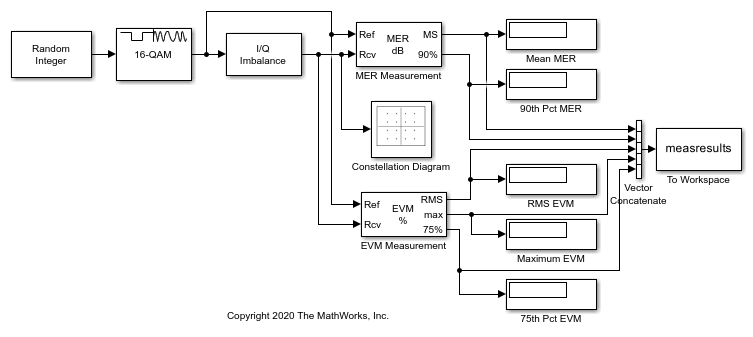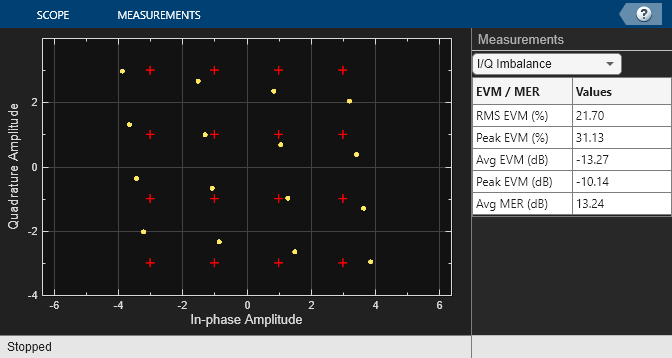EVM Measurement
Measure error vector magnitude (EVM)
Libraries:
Communications Toolbox /
Utility Blocks
Description
The EVM Measurement block measures the root mean squared (RMS) EVM, maximum EVM, and percentile EVM of a received signal. EVM is an indication of modulator or demodulator performance.
This icon shows the block with all ports enabled.![]()
Examples
Ports
Input
Output
Parameters
Block Characteristics
Data Types |
|
Multidimensional Signals |
|
Variable-Size Signals |
|
Algorithms
The implementation supports three normalization methods. You can normalize measurements according to the average power of the reference signal, average constellation power, or peak constellation power. Different industry standards follow one of these normalization methods.
The algorithm calculates the RMS EVM value differently for each normalization method.
| EVM Normalization Method | Algorithm |
|---|---|
| Reference signal |
|
| Average power |
|
| Peak power |
|
In these equations:
ek =
Ik is the in-phase measurement of the kth symbol in the burst.
Qk is the quadrature phase measurement of the kth symbol in the burst.
N is the input vector length.
Pavg is the average constellation power.
Pmax is the peak constellation power.
Ik and Qk represent ideal (reference) values. and represent measured (received) symbols.
The maximum EVM is the maximum EVM value in a frame or where k is the kth symbol in a burst of length N.
The definition for EVMk depends on which normalization method you select for computing measurements. The implementation supports these algorithms.
| EVM Normalization Method | Algorithm |
|---|---|
| Reference signal |
|
| Average power |
|
| Peak power |
|
The implementation computes the X-percentile EVM by creating a histogram of the incoming EVMk values. This output provides the EVM value below which X% of the EVM values fall.
References
[1] IEEE® Standard 802.16-2017. "Part 16: Air Interface for Broadband Wireless Access Systems." March 2018.
[2] 3GPP TS 45.005 V8.1.0 (2008–05). "Radio Access Network: Radio transmission and reception".
[3] IEEE Standard 802.11a™-1999. "Part 11: Wireless LAN Medium Access Control (MAC) and Physical Layer (PHY) specifications: High-speed Physical Layer in the 5 GHz Band." 1999.
Extended Capabilities
Version History
Introduced in R2009b


